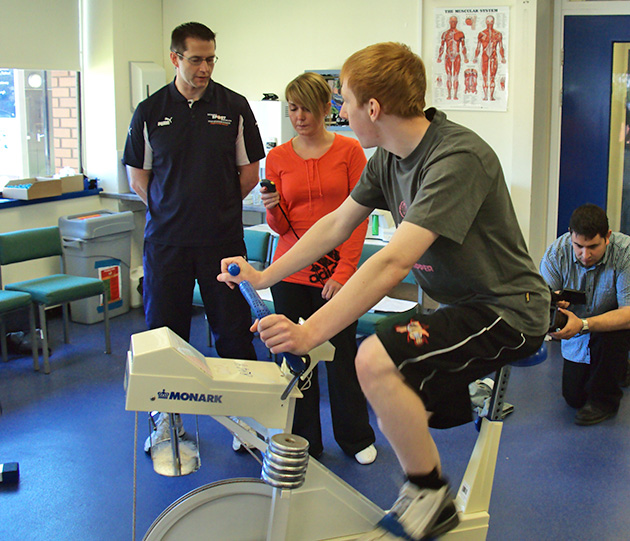The Cycling Repeat Sprint Test is a cycle ergometer test of anaerobic capacity, involving 5 x 6-second efforts performed every 30 seconds. This test is a laboratory alternative to the numerous repeat sprint field tests.
test purpose: the aim of this test is to measure anaerobic capacity.
equipment required: a mechanically braked cycle ergometer (e.g. Monark 894 E Ergomedic, Stockholm, Sweden).
pre-test: Explain the test procedures to the subject. Perform screening of health risks and obtain informed consent. Prepare forms and record basic information such as age, height, body weight, gender, test conditions. Check and calibrate the ergometer. Adjust seat and handlebar height. Perform an appropriate warm-up. See more details of pre-test procedures.
 Monark cycling test
Monark cycling testprocedure: The subject should first perform a cycling warm-up of several minutes. Measure body weight for determination of the resistance load. Set the resistance on the ergometer to 10% of the participant's body mass. The starting position for each cycling bout starts with the pedal set at a 45º pedal angle. The subject is instructed to pedal as fast as possible for 6 seconds, repeating this effort every 30 seconds (e.g. 24 seconds rest).
scoring: calculate total work and sprint power decrement (decrease in power output over the five sprints as a percentage of their best result).
reference: Bishop D, Spencer M, Duffield R, Lawrence S. (2001) The validity of a repeated sprint ability test. J Sci Med Sport. 2001 Mar;4(1):19-29.
Similar Tests
- 10 & 30 second tri-level cycle test of leg power.
- 40 m cycle sprint — maximal cycling speed test
- Wingate Cycle Test — a cycle test of anaerobic leg power, maximal effort over 30 seconds.
Related Pages
- See a video example of the Wingate Test.
- See the list of anaerobic capacity tests for other fitness tests of leg power, including the RAST test which was developed as a running alternative to the cycling Wingate test.
- Fitness tests for cyclists
- Cycle Ergometers
- Cycling Fitness Tests, assessments involving cycling exercise
- About Intermittent Sports Fitness Testing


 Current Events
Current Events